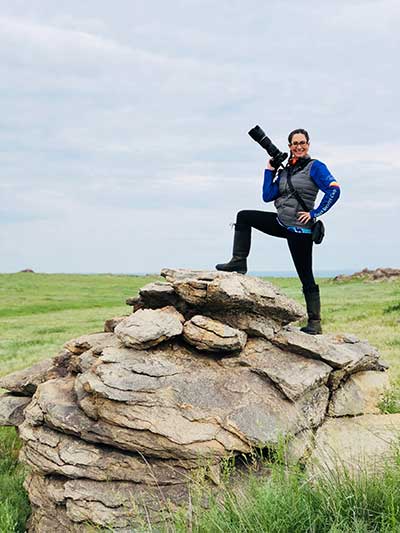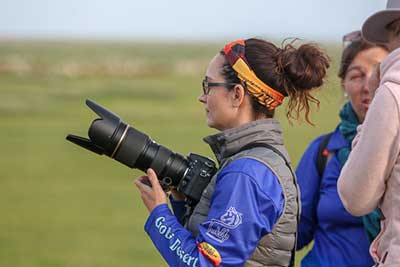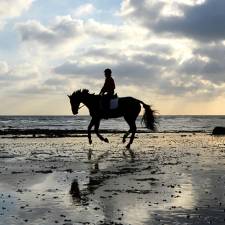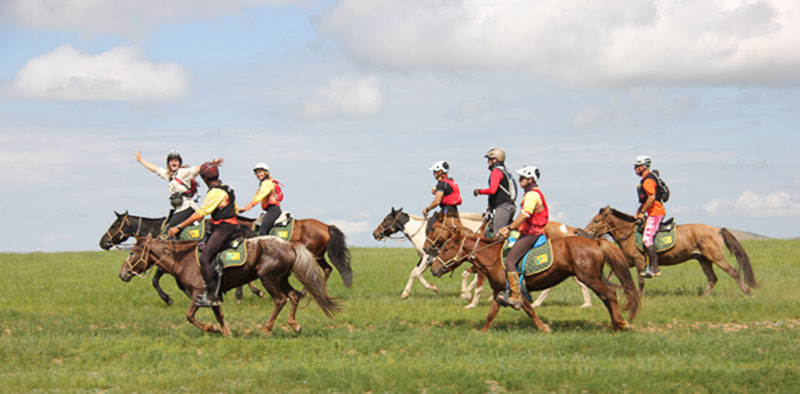
by Heather Wallace
I am a self-styled “Timid Rider.” I love horses, ride often, but lack confidence in my own abilities. So those who know me were shocked when I announced that I would be participating in The Gobi Desert Cup to camp in Mongolia and document the equestrian endurance race across the steppe. Beyond being a self-described “timid rider,” I’m neither a risk taker or a camper for that matter.
This was not an impulsive decision. I did my research before accepting the position as the writer and photographer who would be covering the event. In particular, I was concerned about horse welfare and traveling to an undeveloped country with people that I do not know. For those who may not know, Mongolia is a smaller country sandwiched between Russia to the north and China to the south. Compared to either of its neighbors, Mongolia would be considered a small country. My trainer asked me, “You aren’t riding, are you?” to which I scoffed because of course, I would not be riding in a 300-mile endurance horse race on Mongolian horses across the Gobi Desert. I barely have the stamina to jump a course without needing a beer and a nap afterward.
After speaking with the Co-founder and Ride Director Camille Champagne via Skype at great length, the 3* endurance rider set my mind at ease. A seasoned international rider, Camille’s passion for Mongol culture and the race was incredibly contagious. While only going into its second year, Camille had competed internationally and even completed the Mongol Derby, which gave her the opportunity to meet with and fall in love with the Mongol culture. It was clear that she wanted to support the local nomadic community and invite a select few riders each year to experience it with her.
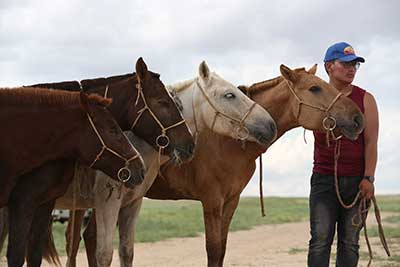
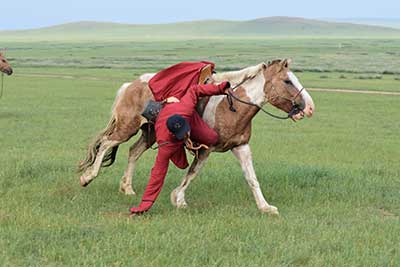
Traveling to Asia
My adventures began on the flight to Ulaanbaatar, the capital city in Northern Mongolia. I’ve traveled internationally many times, but my layover in Beijing is one for the memory books. My flight details showed an hour and forty minutes between flights, but clearly, this was an over-exaggeration. I deplaned and had to check in for my next trip with Air China. The language was a bit of a barrier, but with boarding pass in-hand I made my way to the International Transfer and scanned my passport. DENIED. Again, I scanned it, but still, I was denied. Finally, an employee helped me, and I was waived through to join the security line.
Nothing in my previous travel experience prepared me for Beijing airport security. It is truly exceptional in its thoroughness. As the official photographer, I traveled with my trusted Nikon, multiple lenses, batteries, power banks, and GoPros, which were sponsored for the event. Each item was required to be removed and placed in bins for individual screening. Finally, after an obscene amount of time (and multiple scans) I passed inspection and repacked the entirety of my carry-on luggage, in a full sweat from the effort.
Still my traveling companion, horsemanship trainer Lorie Duff, and I made it to the assigned gate with 30 minutes to spare before our plane was scheduled to take off, only to find no one there.
We spent a solid hour trying to find someone to help us find our plane, including pilots of other flights, only to realize that our plane had flown away without us on it. Apparently, announcements and boarding times in the Beijing airport are subjective.
The fun part? The next flight was not until 8:30 AM the next day. We had traveled 16 hours already and had at least 20 more to go before we could continue our next leg. Stranded in the airport, we tried to have Air China reissue our original tickets for the new flight, but whether it was the language barrier or the propensity of the Beijing employees to point elsewhere and say “No,” we had to pay for the new tickets ourselves.
We were exhausted but determined to make it to Mongolia. I could write a book about the adventures in the Beijing airport, and maybe I will someday. Thankfully we made it on to the morning flight and were en route to the “Land of Eternal Blue Sky.”
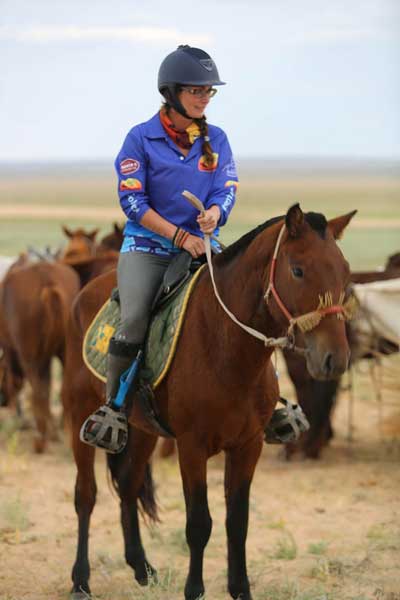
Arriving in Mongolia
The majority of the human population in Mongolia lives in the capital city of Ulaanbaatar, and it is apparent. The roads are congested and the air pollution creates a thick smog. Drivers were sitting in traffic taking out rags to wipe the dust off their dashboards and steering wheels while cars moved in inexplicable patterns that would confound the best traffic planning if such a thing actually existed in Mongolia!
I learned Mongols are afraid of nothing, especially driving. Roads are optional, and if you have to drive on the grass to get where you need to go, so be it. The animals and humans better move, because if they don’t, it’s just too bad.
Finally, we made it to the hotel, and I immediately found the bulk of the other officials consisting of Camille Champagne, Dr. Ann Lammens, Rosie Barr, and Colleen Shaw. It was lovely to meet everyone in person after months of online communication, and I launched into the story of my travel adventures. It appeared I wasn’t the only one who experienced trouble in Beijing.
First Impressions
The air of excitement was profound, and the riders gathered together for a briefing by Dr. Lammens, the FEI 3* veterinarian and Head Vet for The Gobi Desert Cup. After a limited time in the city due to my travel delays, we were off to find basecamp.
I learned from my earliest moments that Mongolia is unpredictable. The weather is unpredictable, the drivers are unpredictable, and if you want to enjoy yourself, you have to learn to love being in a constant state of unpredictability.
Our travels to base camp were delayed due to rain, and so we took the long way to tour a 13th-century Ger and then continued on our way to our final destination. If I thought driving in the city was scary, I learned quickly I needed to adjust my expectations.
We had five Russian trucks, and they were determined to race each other in their own version of the Mongol Rally. Up and down dirt tracks, sometimes not even on those, to outdo each other caused me to learn very quickly why the ceilings of these vehicles were cushioned.
But after eight hours of travel, on dirt roads and highway, we made it to our final destination.
Finally, I received my first glimpse of the “Land of the Horse.” Ahead of me was a beautiful expanse of Gobi Desert Cup tents, overlooking a traditional horse line holding 130 beautiful, sturdy Mongolian horses. The sight before me made my earlier adventures so wholly worth the drama of the previous 72 hours.
I had a lot of expectations for Mongolia and The Gobi Desert Cup. But despite learning everything I could in advance, and often speaking with Camille about the event, nothing prepared me for the real thing. All my expectations were blown away. From the beginning, I knew I would never be the same.
The Gobi Desert Cup hires nomadic herdsmen and local veterinarians who train, condition and prepare their horses for the international riders. These locals were the same ones in the inaugural 2017 ride, and the warm greetings filled with laughter and hugs to Camille showed how close a group they are. Camille refers to them as “family,” and they refer to her as “Sister Camila.” The close bonds were immediately apparent.
More, the excitement of the race and the international riders brought the families to base camp. These families couldn’t wait to show us their favorite pastime: horse racing, wrestling, and clubbing. I had a lot of fun watching the children race (yes children!), but the clubbing was my favorite. The herdsmen would throw a whip on the ground then gallop up, coming almost entirely out of the saddle to scoop it off the ground/capture it again off the ground and back into their saddles. I captured some great moves on my camera, and then men surrounded me, bragging to each other, and wanting to try again to get better photos. We had a lot of fun!
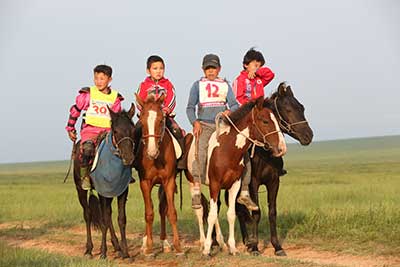
The Riders
Eighteen riders from seven countries converged on Mongolia for the chance to win The Gobi Desert Cup. Riders ranging in age from 25 to 71 years old from different disciplines and experience levels, came to live as a unit for 10 days. Riders chose a tentmate and teams of four to ride with over the course of the week.
What struck me was how quickly everyone banded together with the shared experiences. Virtual strangers, who had communicated only on social media in advance, were now living together and sharing the adventure of a lifetime. While some riders got along better than others, I was shocked at the camaraderie of the group as a whole. I fully expected cliques and segments to appear, but they really did not occur. Even those riders who were less social were welcomed with open arms when they did join the meals and nightly entertainment, which consisted of funny stories from the day, cards, or even a little dancing in the moonlight.
We were all, officials and riders, united by our love of adventure and for the opportunity to be there learning and experiencing everything we could in our short time.
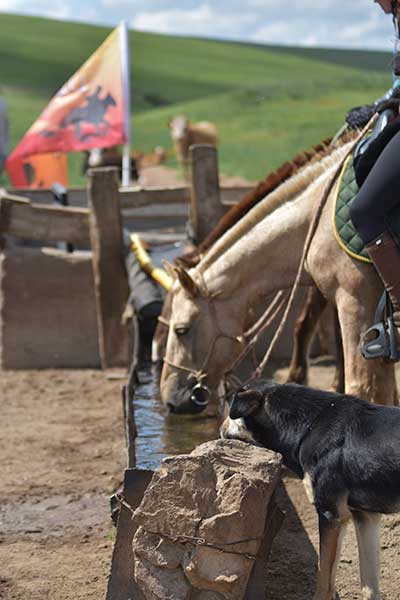
The Race
The Gobi Desert Cup was my first endurance horse race, but it is unique in many ways. First, it’s in Mongolia. Second, it’s on Mongolian horses rather than traditional Arabians. Third, while each day riders were awarded points based on finish placings and horsemanship, the competition was only part of the journey. In fact, it was astounding to watch seasoned endurance riders and less experienced riders work together and help each other, often tying for the finish line. I could often hear the riders commenting that while they wanted to win, they were there for the adventure.
Traveling 300 miles throughout the Gobi Desert and its various terrains was an exceptional way to view the countryside. Riders were given the opportunity to see the world through the eyes of a Mongol and step back to a simpler time: no electricity, no plush mattresses, and lots of time on horseback.
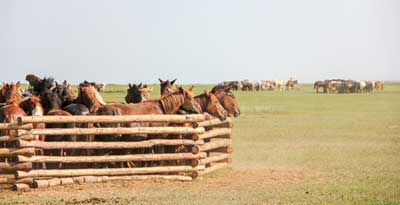
On one particular day, a few of the riders went off course because they didn’t see the markers. Each had their own experience which is unique to Mongolia but involved the hospitality of strangers and the willingness of those nomads to help a fellow horsewoman and horseman. They shared their water and food, took photos and helped them find their way back to the track.
I’ll admit that it didn’t take me long to envy the riders. While I have no desire to ride a horse 50 miles a day, the apparent thrill the riders experienced was contagious. Each day the riders had a different horse, which required they learn and bond with six horses over six days. No horse was ridden twice. The riders named their animals and shared their journey, trusting them over the often uneven footing. In return the riders showed exceptional care for their horses, resulting in less than a 5% elimination rate and no injuries to horses or riders. As a point of reference, the average elimination rate in endurance is 40%, so this is quite a significant success!
.jpg)
My Learning Experience
The envy was there, but it was envy mixed with a healthy level of caution, because I knew that I would never want to ride a horse that was unsafe. However, these horses were so much better trained than I’d anticipated! So when the officials discussed an “Official’s Race” following the finish line on the 6th day, I was all for it. Until the moment I had to mount and panic set in. Remember how I mentioned I’m a timid rider?
A herdsman presented me with a beautiful bay horse, and he promised that he was very kind and gentle. I think he saw the panic in my face. I did mount, but when it turned out another saddle was needed, I immediately volunteered to dismount and sit this one out. Luckily, the others ignored my attempt at baling, and the riders soon began placing bets. Like I needed extra pressure!
So there I was, about to gallop across a portion of the Gobi desert on a Mongolian horse against four veterinarians, which included a herdsman, and a 3* endurance rider. Awesome. Least qualified, right here.
Trying to swallow my nerves and breathe deeply, I followed the others at a walk to the starting line. They promised we would walk, trot, canter, and then gallop at the end to help my anxiety. Except that when we turned to start, Camille’s horse began to trot, mine went immediately into a collected canter. After that, Camille’s competitive drive kicked in and we were off! Sometimes you just have to go with it, as Mongolia taught me and I launched into a gallop neck and neck with the co-founder of The Gobi Desert Cup!
I wish I could say I won that race, but not only did I start to tire halfway through (I’m not as fit as I would like) but two other riders came from behind to kick-start another gear to the finish. I happily came in 4th, in one piece, and with cheers from the riders and herdsmen alike spurring me on.
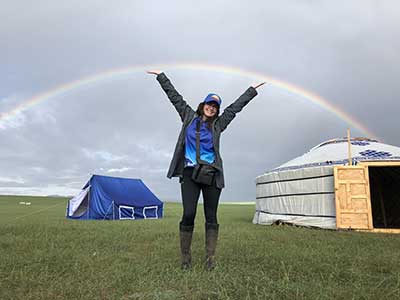
Mongolia has taught me a lot about its culture, its horses, but most of all about myself. First, I will try to avoid Beijing in future (we had another issue on the return trip); second, I am braver than I thought; third, I can be spontaneous; and fourth, you don’t have to be born into a family. The bonds that were formed during the 2018 Gobi Desert Cup will remain strong and united despite time and distance. We experienced the equestrian adventure of a lifetime together and everyone had something to teach me.
I cried when I said goodbye to my friends and Mongolia. Each rider had a different experience and a separate test whether physical, mental, or emotional. My experience was a reset that I needed to evaluate my life and what I want out of it. I can still be the person afraid to try, or I can be the person afraid to fail who puts in her best effort in spite of her fears.
How do you think The Gobi Desert Cup would test you?
About the writer: Heather Wallace is a certified equine and canine sports massage therapist, author, and Content Manager for EquineInfoExchange.com as well as the Media Consultant for The Gobi Desert Cup. Her bestselling book, Confessions of a Timid Rider, details her insights about being an anxiety-ridden but passionate equestrian. In her spare time (of which she has little), she spends her time with her husband, three children, two dogs, and pony. You can follow her on social media @timidrider or at timidrider.com.
Find out more about Vacations in our Travel & Tourism section.
